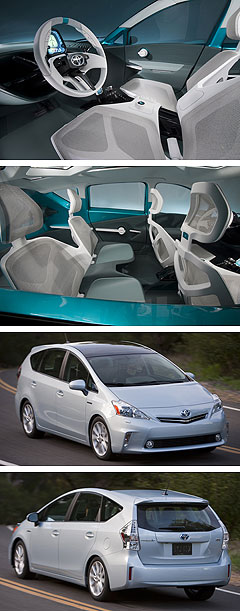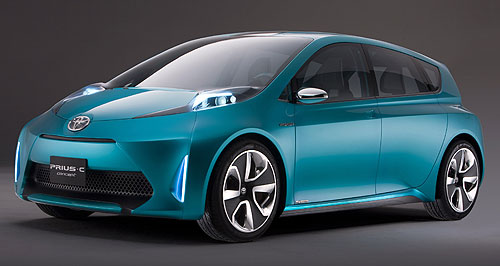Future models - Toyota - Prius - CToyota re-thinks hybrid strategyAround the corner: The Prius C small-car will join Toyota's Australian line-up in the first half of 2012. Hybrid benefits to be front and centre as Toyota prepares for wave of new models25 Aug 2011 TOYOTA Australia is planning to change tack on its hybrid vehicle marketing after disappointing sales of its pioneering Prius and Camry Hybrid lines, with more emphasis on selling the sizzle than the steak. The company’s senior executive director sales and marketing David Buttner said at this week’s 2012 Camry reveal in Melbourne that Toyota had tried to educate the public about the hybrid technology in its petrol-electric cars, describing its go-it-alone efforts as ‘Robinson Crusoe’. He said that because Toyota had been a leader in landing hybrid cars on the market (technically, Honda was first with its original Insight mild-hybrid in 2001) it had been forced to try to dispel the myths surrounding this new technology. Now, with the Prius C compact hatch and Prius V wagon set to join the range in the first half of 2012, Toyota believed it was time to place more emphasis on the benefits of hybrid technology, he said. “We have tried a lot of strategies to dispel the myths, talking about two engines working as one, but we are considering whether that is the best way to approach the market place or if there is a better way of doing it, where it is more engaging,” he said. Toyota has consistently fallen short of publicly stated sales targets for its hybrid cars. In 2009, it predicted 4500 Prius sales for 2010, but shifted just 1611 – down 47 per cent on 2009’s 3040 units.  Left: Prius C concept interior. Below: Prius V. Left: Prius C concept interior. Below: Prius V.This year, sales are down almost 70 per cent, with just 358 Prius hybrids leaving showrooms in the seven months to date, although at much of that decline might be attributed to stock shortages due to the Japanese earthquake and tsunami in March. Although Camry Hybrid sales are not broken out from standard petrol Camry sales figures in the official VFACTS data, GoAuto understands they have been well short of Toyota’s original aspirations. Mr Buttner revealed the hybrid marketing strategy had been the subject of considerable debate in Toyota Australia offices, as it prepared to expand the range. “Do you know how your plasma TV works? Do you know your microwave oven works?” he said. “Do you care, as long as you get a good picture and your food comes out hot?“We are really questioning from a marketing and strategic point of view whether we have been spending too much time trying to educate the consumer rather than talk about the benefits of the technology. “We have got some different and exciting means of bringing the product to market.” Toyota’s entire hybrid range will not only be expanded but existing cars will be overhauled in the first half of 2012, with the arrival in the first quarter of the new baby of the range, the Prius C hatchback, to sit below the current third-generation Prius that will get a facelift around the same time. The larger Prius V wagon will lob in the second quarter, although Mr Buttner said Toyota was still debating whether to introduce the five-seat version or the seven-seat iteration – known elsewhere as the Prius+ - or both. On top of those Prius additions, Toyota will introduce the all-new locally made Hybrid Camry, boasting an all-new powertrain that is said to be capable of driving up to 2.6km on electric power alone if driven slowly. Over at Toyota’s prestige division, Lexus, the new GS450h hybrid luxury car is due to hit Australian showrooms in 2012 after making its first public appearance at the Frankfurt motor show next month. Also at Frankfurt, the plug-in Prius will make its formal debut in final production guise, although Mr Buttner said it was still under consideration for Australia where a fleet of Prius PHEVs (plug-in hybrid electric vehicles) are being tested by fleets. “We have still got cars out on trial, but we haven’t made a definitive decision on when we will bring it in, if or when we bring it in,” he said. Earlier this month, Toyota revealed the Prius PHEV could achieve fuel economy of 2.2 litres per 100km and CO2 emissions of 49g per kilometre, making it almost twice as efficient as the standard Prius that consumes 3.9L/100km and emits 89g/km of CO2 on the combined cycle. Mr Buttner welcomed the news that Toyota had done a deal with rival Ford to share hybrid technology development for SUVs and light trucks. He said the cost of going it alone in such development programs was prohibitive. “You bring the skills sets together from a couple of companies, you pool you resources, you split your development costs, R&D effort – it is fantastic,” he said.  Read more27th of June 2011  AIMS: Toyota confirms city PriusThrifty Toyota Prius C to set new hybrid benchmark when it arrives in 2012Prius pricing
Motor industry news |
Click to shareToyota modelsResearch Toyota Prius pricing
Motor industry news |
















Facebook Twitter Instagram